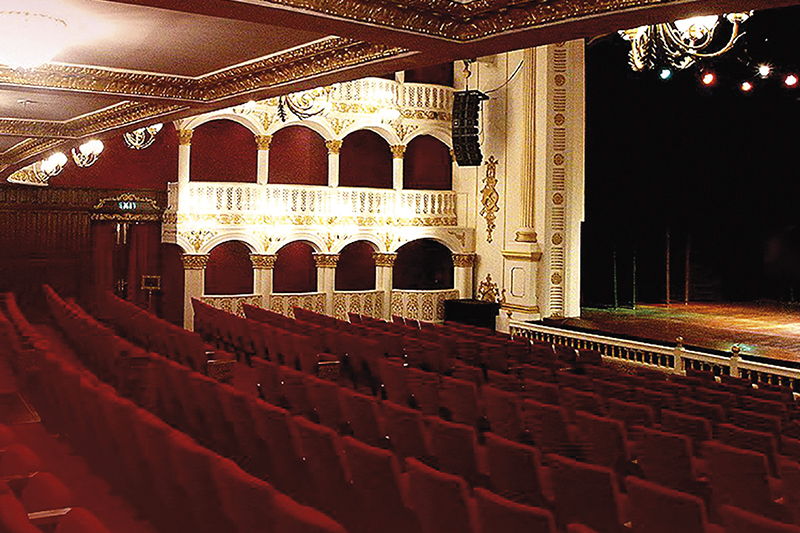
The Treasure Trove of Mumbai
Vibrant, exhilarating, chaotic. Every corner of India’s largest city captivates wanderers with its colourful and bustling human drama. Presented here are three of its most spellbinding cultural gems
Words: Sarita Urupongsa
CULTURAL POWERHOUSE
When it comes to the jewel in Mumbai’s cultural crown, there’s really only one contender. More than 100 years after it rose majestically on the skyline, the Royal Opera House still shines brightest among the city’s arts venues with a rolling programme of plays, films, music and dance. In the early 1900s, the city then known as Bombay was famous as an artistic melting pot – but the bubbling sophistication reached boiling point when a grand European-style opera house was added to the mix. The spectacular Baroque edifice with Indian detailing was the 1908 brainchild of Calcutta entertainer Maurice Bandmann and coal tycoon Jehangir Framji Karaka.
After being inaugurated by King George V in 1911, the finishing touches were added in 1916 – just in time to catch the wave of silent cinema from Hollywood. By 1917 it was doubling as a cinema hall, and films were sharing the space with operas. The theatre closed in 1925 but the arrival of “talkies” in the early ‘30s attracted huge crowds and saw Bombay’s Baroque beauty rise again.
The Maharaja of Gondal bought the Opera House in 1952, but by the 1980s audiences had dwindled due to the rise of video. The Opera House finally closed its doors in 1993 and sat crumbling for years. That was until Shri Joytendrasinhji, the son of the Maharaja, commissioned renowned architect Abha Narain Lambah to restore the building to its former grandeur in 2010.
Ms. Lambah’s devotion to her task was rewarded with the Unesco Asia-Pacific Award for Cultural Heritage Conservation and the Opera House’s inclusion in the 2012 World Monuments Watch.
Nowadays, India’s only surviving opera house is once again a favourite destination for Mumbai’s culture lovers. Get a taste of this classical powerhouse of culture by checking out its upcoming shows at royaloperahouse.in.
Mama Parmanand Marg, Mumbai, royaloperahouse.in
BIG DRAMA IN A SMALL SPACE
Built by Bollywood icon Shashi Kapoor in memory of his father, Prithviraj Kapoor, a legend in his own right, Prithvi Theatre opened its doors to artists and audiences in 1978. The non-profit theatre survives on the patronage of individuals and corporates with a shared commitment to cultivating performing arts in the city.
Describing itself as “an intimate space for theatre and performing arts”, Prithvi promotes and inspires theatrical excellence by nurturing its artists and performers and providing them with all they need to make their work stand out. The focus is on new and challenging plays in Hindi and English, so check the website to find out if surtitles are provided. Theatre is taken seriously at Prithvi, where staff do their utmost to ensure the bubble isn’t broken by the ungodly ring of cellphones and that no tickets are sold after 15 minutes prior to the show.
Shows are staged at the theatre from Tuesday to Sunday. 20 Janki Kutir Juhu Church Road, Mumbai, prithvitheatre.org, facebook.com/prithvitheatre
VISIT THE ARCHITECT OF INDIA
The famous name of Jawaharlal Nehru goes far beyond the narrow realm of politics in India. Nehru’s legacy is rooted in the country’s fight for independence and the victory of its first secular government. It was Nehru who led that government, as India’s first prime minister.
Nehru Centre was conceived in 1972 as a living testament to his life’s work, vision and faith, and it continues to inspire the new generation with the spirit of the statesman described as the architect of India.
The centre is divided into eight sections, starting with the planetarium, which was commissioned in March 1977 as a centre for the study of astronomy. Then came the Discovery of India permanent exhibition, which captures the identity of the country in a variety of media, ranging from architecture and photographs to audio-visual displays. This section also hosts workshops that offer an alternative approach to science.
Other sections include the Culture Wing, with rotating cultural programmes; the Art Gallery, which is dedicated to promoting young talents; and the horticulture hub which hosts thousands of rare trees. There’s also the auditorium, library and exhibition space.
Check out Nehru-centre.org for programmes, performances and exhibitions. Nehru Centre, Dr. Annie Besant Road, Worli, Mumbai, Nehru-centre.org.
